Top 10 Epic Hiking Trails in Asia for 2024: Must-See Guide
- April 2, 2024
- 0 comment
Discover 2024’s top 10 epic hiking trails in Asia with our must-see guide. Adventure awaits in breathtaking landscapes. Set out on a journey through Asia’s most breathtaking landscapes with our curated list of the top 10 epic hiking trails for 2024. From the snow-capped peaks of the Himalayas to the lush rainforests of Southeast Asia, each trail offers a unique adventure that promises to be both challenging and rewarding.
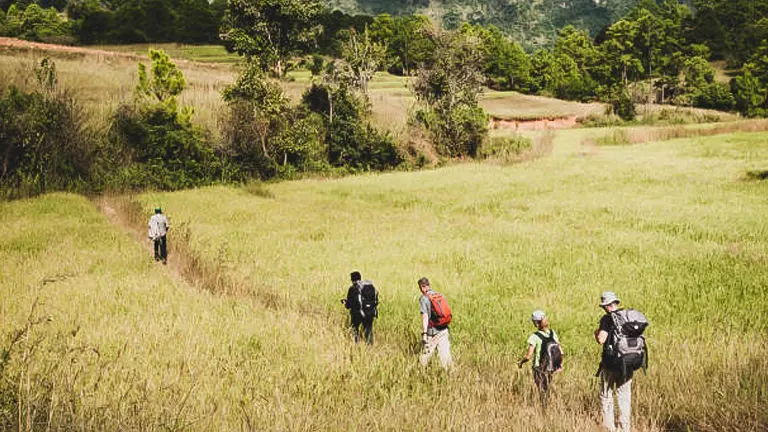
Whether you’re a seasoned hiker looking for your next conquest or a nature lover seeking to immerse yourself in stunning scenery, this guide is your gateway to exploring the unparalleled beauty that Asia has to offer. Get ready to lace up your boots and set off on an unforgettable journey through some of the most awe-inspiring terrains our planet has to offer.
List of Top 10 Epic Hiking Trails in Asia for 2024
- Everest Base Camp Trek
- Mount Kailash Trek
- Kalaw to Inle Lake
- Tiger Leaping Gorge
- Taman Negara National Park
- Mount Bromo
- Annapurna Circuit
- Jeju Olle Trail
- Markha Valley Trek
- Ha Giang Loop
Criteria for Selecting the Top 10 Epic Hiking Trails in Asia
In curating this list of the top 10 epic hiking trails in Asia for 2024, several critical factors were considered to ensure a diverse and comprehensive guide that caters to a range of interests and abilities. The trails selected meet the following criteria:
- Scenic Beauty: Each trail offers unparalleled natural beauty, from majestic mountain peaks and lush forests to serene lakes and unique geological formations. The visual splendor of these trails promises memorable experiences for all who traverse them.
- Cultural Richness: Hiking is not just about the physical journey but also about cultural immersion. The trails chosen provide opportunities to engage with local communities, understand their traditions, and learn about the history that shapes the landscape.
- Accessibility: While some trails pose significant challenges suitable for experienced hikers, others are more accessible to beginners. This diversity ensures that adventurers of all skill levels can find a trail that matches their abilities.
- Environmental Conservation: Trails that promote and practice sustainable tourism were prioritized. It’s crucial that our exploration respects and preserves the natural environments we’re privileged to enjoy.
- Adventure Quotient: Each trail offers unique challenges or experiences that set it apart, whether it’s crossing ancient trade routes, navigating through remote wilderness, or tackling high-altitude passes. The promise of adventure is a key component of each trail’s appeal.
Top 10 Epic Hiking Trails in Asia for 2024
1. Everest Base Camp Trek, Nepal

The Everest Base Camp Trek is an expedition that tests limits and rewards with unparalleled views of the highest point on earth. Covering approximately 130 kilometers round trip, this path elevates adventurers to a staggering 5,364 meters above sea level, providing a rare glimpse into the world above the clouds.
- Difficulty: Rated as challenging, this trek demands excellent physical condition, acclimatization to high altitudes, and determination.
- Unique Features: This trek is more than an adventure; it’s a cultural immersion into the heart of Sherpa country. Vibrant monasteries and welcoming teahouses dot the landscape, offering insights into the lives of the mountain communities. The trail’s biodiversity is as remarkable as its scenery, ranging from dense forests to barren rock faces, each hosting unique species that call this harsh environment home.
- Best Time to Visit and What to Expect: Optimal trekking conditions are found from March to May and September to November when the skies are clearest, and the weather is most stable. Trekkers should prepare for a physically demanding journey, with acclimatization days essential to adapt to the altitude. It’s also vital to consider the environmental impact and ensure that all travel is conducted responsibly, preserving this magnificent landscape for future generations.
- How to Get There: Most journeys to Everest Base Camp begin with a flight from Kathmandu to Lukla. From Lukla, trekkers typically spend the next few days hiking to the base camp.
2. Mount Kailash Trek, Tibet

Mount Kailash, revered as a sacred mountain by multiple religions, stands at 6,638 meters. The trek to its base is not just a physical challenge but a spiritual pilgrimage offering solace and enlightenment. Spanning 52 kilometers, the path around the sacred mountain is a journey through some of Tibet’s most untouched landscapes.
- Difficulty: This trek is considered to be of moderate to high difficulty, requiring good physical health and spiritual reverence as it serves as a pilgrimage for many.
- Unique Features: The trek provides a path through pristine Tibetan nature, with breathtaking views that stretch across the horizon. It’s a spiritual odyssey as much as a physical one, taking trekkers through high-altitude lakes, rugged mountainsides, and serene spaces of worship that have been visited for thousands of years.
- Preparation Tips and Cultural Respect: Physical preparation and acclimatization to high altitudes are crucial for those undertaking this journey. Equally important is the approach to the trek with a sense of respect for its cultural and religious significance. Travelers are encouraged to learn about the customs and traditions to engage with the local culture respectfully.
- How to Get There: Access to Mount Kailash usually involves flying to Lhasa, Tibet’s capital. From Lhasa, travelers can take a combination of long drives and short treks to reach the starting point of the Kailash Trek.
3. Kalaw to Inle Lake, Myanmar

The trek from Kalaw to Inle Lake in Myanmar unveils a hidden paradise, weaving through rolling hills, traditional villages, and verdant landscapes. This journey, typically spanning 2 to 3 days, immerses travelers in the rural beauty of Myanmar, ending at the serene Inle Lake.
- Difficulty: This trek is rated from moderate to challenging, depending on the chosen route and weather conditions. It’s accessible to most hikers who are in good physical shape.
- Unique Features: The path offers an authentic experience of Myanmar’s countryside, with opportunities to interact with local hill tribes and witness their daily lives and traditions. The trail’s end, Inle Lake, is renowned for its floating gardens and leg-rowing fishermen, offering a tranquil contrast to the trek’s more rigorous sections.
- Best Time to Visit and What to Expect: The best months to embark on this trek are from November to February, when the weather is cooler and dry. Trekkers should prepare for variable terrain, including some steep sections, and the chance to explore Myanmar’s rich cultural heritage up close.
- How to Get There: Visitors can reach Kalaw by bus or car from major cities like Yangon and Mandalay. The trek concludes at Inle Lake, from where you can continue your journey by boat or road.
4. Tiger Leaping Gorge, China

One of China’s most famous treks, Tiger Leaping Gorge, offers dramatic landscapes and a thrilling challenge. The gorge, one of the deepest in the world, features a trail that spans about 22 kilometers and takes hikers along the Jinsha River’s rugged terrain, with spectacular views of the Jade Dragon Snow Mountain.
- Difficulty: The trek is considered moderately difficult, suitable for hikers with some experience. The path includes steep ascents and descents, but it’s well-marked and navigable.
- Unique Features: The gorge is named after a legend that a tiger leaped across its narrowest point. Trekkers can expect breathtaking vistas, towering cliffs, and the powerful river below. The area is also home to diverse flora and fauna, including rare plant species and wildlife.
- Best Time to Visit and What to Expect: The optimal times for trekking are spring (April to June) and fall (September to November) when the weather is mild and the views are clear. Hikers should be prepared for sudden weather changes and carry enough supplies, as there are limited facilities along the trail.
- How to Get There: The nearest major city to Tiger Leaping Gorge is Lijiang. Buses from Lijiang to Qiaotou, the trail’s starting point, run regularly.
5. Taman Negara National Park, Malaysia

Taman Negara National Park, one of the world’s oldest rainforests, offers hikers an immersive experience in a tropical paradise. Trails range from short, easy walks to challenging multi-day treks, allowing adventurers to explore the park’s vast biodiversity.
- Difficulty: The park caters to all levels of hiking ability, from easy routes for families to challenging treks for experienced hikers.
- Unique Features: The park is a haven for wildlife enthusiasts, home to rare species such as Malayan tigers, Asian elephants, and exotic birds. Highlights include the world’s longest canopy walkway, offering a bird’s-eye view of the forest, and night safaris to observe nocturnal creatures.
- Best Time to Visit and What to Expect: The dry season from February to September is ideal for hiking, as trails are less muddy and rivers are easier to cross. Visitors should be prepared for high humidity and should pack accordingly, with plenty of water and insect repellent.
- How to Get There: Kuala Lumpur is the starting point for most travelers, with buses and trains available to Jerantut. From Jerantut, visitors can take a local bus or a boat to the park.
6. Mount Bromo, Indonesia
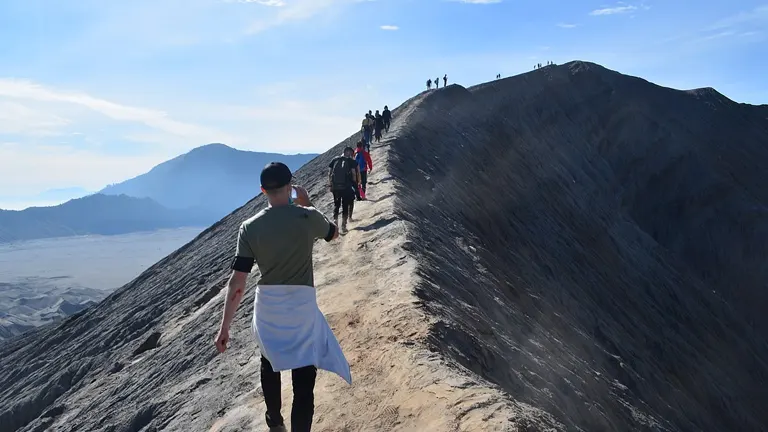
The trek to the summit of Mount Bromo, an active volcano in Java, Indonesia, is a journey through a lunar-like landscape to witness one of the most stunning sunrises over the caldera. The trek itself is relatively short but offers an unforgettable experience.
- Difficulty: This trek is considered easy to moderate, making it accessible to most hikers, including beginners. The ascent to the viewpoint can be done on foot or by horseback.
- Unique Features: Mount Bromo is part of the Tengger Semeru National Park, known for its dramatic volcanic landscape. The viewpoint offers panoramic views of the Tengger caldera, Mount Batok, and Mount Semeru, Java’s highest peak. The area’s cultural heritage, particularly the Tenggerese people, adds a fascinating layer to the visit.
- Best Time to Visit and What to Expect: The best time to visit is during the dry season, from April to October. Early morning treks to catch the sunrise are highly recommended. While the climb is not particularly strenuous, the altitude and cold temperatures at the summit require appropriate clothing. Also, being respectful of the area’s cultural and natural significance is important for all visitors.
- How to Get There: The nearest major city to Mount Bromo is Surabaya, which is accessible by plane from Jakarta and other Indonesian cities. From Surabaya, visitors can take a bus or arrange a tour to Cemoro Lawang, the gateway to Mount Bromo.
7. Annapurna Circuit, Nepal
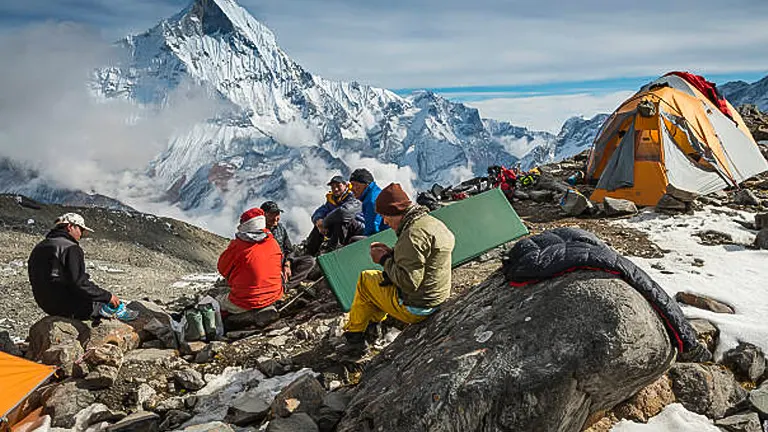
The Annapurna Circuit, circling the Annapurna massif, is renowned for its diverse scenery, ranging from subtropical forests and paddy fields to high mountain passes. This trek covers about 160 to 230 kilometers, depending on the chosen route, offering a full circle of the Annapurna range.
- Difficulty: This trek is considered challenging due to its length and the high altitudes involved, particularly crossing the Thorong La pass at 5,416 meters. It requires good physical fitness and acclimatization to altitude.
- Unique Features: The circuit provides a spectacular showcase of cultural and natural diversity, including ancient Buddhist monasteries, traditional villages, and views of some of the world’s highest peaks. The trail’s biodiversity is equally impressive, with chances to spot rare wildlife.
- Best Time to Visit and What to Expect: The best periods for trekking are from March to April and October to November, when the weather is favorable, and the views are clear. Trekkers should be prepared for varying climatic conditions and ensure they have the necessary permits and gear for high-altitude hiking.
- How to Get There: The trek typically starts in Besisahar, which can be reached by bus from Kathmandu. The journey to Besisahar is an adventure in itself, offering glimpses of rural Nepalese life.
8. Jeju Olle Trail, South Korea
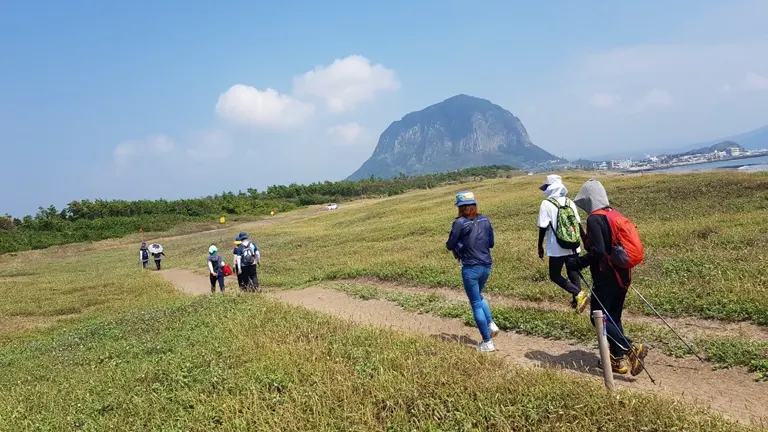
The Jeju Olle Trail encompasses a series of walking paths around Jeju Island, known for its volcanic landscapes, lush countryside, and beautiful beaches. The trail network offers various routes, each revealing different aspects of the island’s natural beauty and cultural heritage.
- Difficulty: The trails vary in difficulty, with most being accessible to hikers of all levels, including families. The pathways are well-marked and maintained, providing a leisurely hiking experience.
- Unique Features: Highlights include walking along the coastline with views of the turquoise sea, exploring lava tubes and craters, and experiencing Jeju’s unique island culture. The routes also pass through small villages, where hikers can sample local cuisine and hospitality.
- Best Time to Visit and What to Expect: Spring (April to June) and fall (September to November) are ideal for hiking the Jeju Olle Trail, with mild weather and the natural landscape at its most vibrant. Hikers should pack light rain gear and sun protection, as the weather can be unpredictable.
- How to Get There: Jeju Island is accessible by flights from Seoul and other major cities in Korea. The island’s extensive bus system can then be used to reach various starting points of the Olle Trail.
9. Markha Valley Trek, India
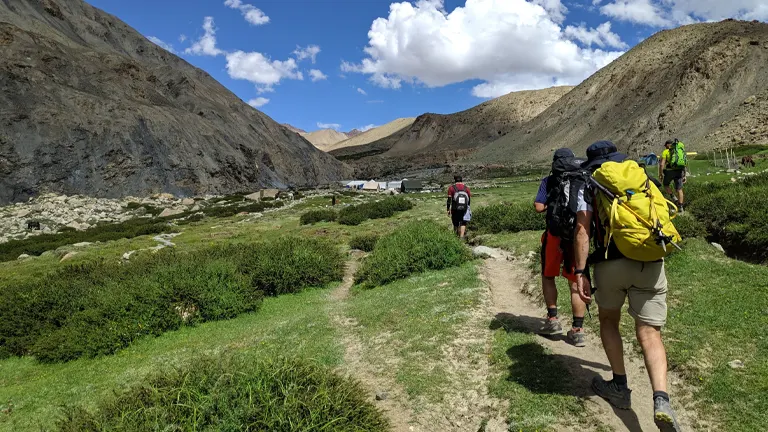
Situated in the Indian Himalayas, the Markha Valley Trek is a journey through remote landscapes, offering stunning views of the Ladakh and Zanskar ranges. The trek spans approximately 75 kilometers, crossing through arid deserts, green valleys, and small villages.
- Difficulty: Rated as moderate to difficult, the trek involves crossing high passes, including the Kongmaru La at 5,260 meters. It’s suitable for trekkers with some experience in high-altitude hiking.
- Unique Features: The trek features ancient Buddhist monasteries, traditional Ladakhi villages, and the chance to see diverse wildlife. The stark beauty of the high desert terrain, combined with the rich cultural experiences, makes this trek truly unique.
- Best Time to Visit and What to Expect: The best time for the Markha Valley Trek is from June to September when the passes are clear of snow, and the weather is relatively warm. Trekkers should be well-prepared for cold nights and the potential for high-altitude sickness.
- How to Get There: The closest major airport is in Leh, Ladakh. From Leh, trekkers can hire a taxi or join a tour to reach the starting point of the trek in Spituk or Chilling.
10. Ha Giang Loop, Vietnam
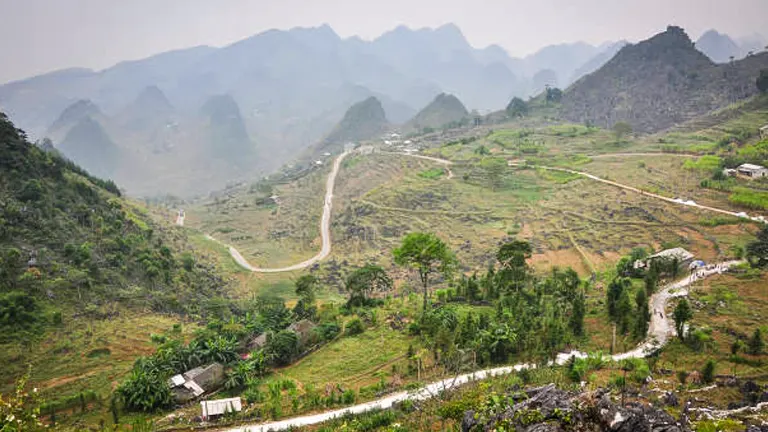
The Ha Giang Loop, in Vietnam’s northernmost province, offers an adventurous ride through a landscape of steep hills and deep valleys. While often traversed by motorbike, the route also presents an epic challenge for hikers, spanning over 300 kilometers of rugged terrain.
- Difficulty: This journey is considered challenging due to the rough terrain, elevation changes, and the distance involved. It’s best suited for adventurous hikers looking for an off-the-beaten-path experience.
- Unique Features: The loop passes through areas of outstanding natural beauty, including the Dong Van Karst Plateau Geopark, and offers insights into the lives of various ethnic minority groups. The terraced rice fields, blooming with colors depending on the season, are a highlight.
- Best Time to Visit and What to Expect: The best times to hike the Ha Giang Loop are during the spring (March to May) and fall (September to November), when the weather is pleasant, and the rice terraces are at their most picturesque. Hikers should be prepared for basic accommodations and should respect the local cultures and traditions they encounter.
- How to Get There: Ha Giang can be reached by bus from Hanoi. The journey takes approximately 6-8 hours. Once in Ha Giang, adventurers can begin the loop either on foot or by motorbike, with the latter being the most popular option.
Hiking and Safety Tips for Adventurers
Embarking on a hiking adventure, especially in the diverse terrains of Asia, requires careful planning and preparation. Here are essential tips to ensure safety and enhance your hiking experience:
1. Know Before You Go:
- Research: Thoroughly research your chosen trail. Understand the difficulty, duration, and any specific challenges you might face.
- Weather: Check the weather forecast and be prepared for sudden changes. Mountain weather can be unpredictable.
- Permits and Regulations: Some trails require permits or have specific regulations. Ensure you have the necessary permissions and understand the local rules.
2. Gear Up:
- Appropriate Footwear: Invest in good quality hiking boots that provide support and grip.
- Layered Clothing: Weather conditions can change rapidly. Wear layers that you can add or remove as needed.
- Navigation Tools: Carry a map, compass, or GPS device. Ensure your GPS is charged and consider carrying a power bank.
- Emergency Kit: Include a first-aid kit, flashlight, whistle, and fire-making tools. Familiarize yourself with how to use these in case of an emergency.
3. Stay Healthy:
- Hydration: Carry enough water and know where you can safely refill along the trail. Dehydration can be a serious risk.
- Nutrition: Pack high-energy, nutritious snacks and meals. Consider your energy needs based on the trail’s difficulty and duration.
- Acclimatization: For high-altitude treks, plan for acclimatization days to prevent altitude sickness. Recognize the symptoms and know when to descend.
4. Respect Nature:
- Leave No Trace: Carry out what you carry in. Respect wildlife and keep a safe distance. Stay on marked trails to prevent erosion and protect habitats.
- Campfire Safety: If camping, understand the regulations regarding campfires. Use designated fire pits and never leave a fire unattended.
5. Communicate and Plan:
- Inform Someone: Always let someone know your plan, including which trail you’re taking and when you expect to return.
- Emergency Plan: Know the local emergency numbers and the nearest points of assistance. Carry a charged phone or satellite communicator in remote areas.
6. Join a Group or Hire a Guide:
For challenging or remote trails, consider hiking with a group or hiring a local guide. Their expertise and knowledge of the terrain can enhance safety and enrich your experience.
Related Post
- Explore the Top 15 Must-See Hiking Trails in Colorado for 2024: Your Ultimate Guide
- Discover the Top 15 World’s Most Spectacular Waterfalls: The Ultimate Traveler’s Bucket List
- Discover the Top 12 Mountain Bike Trails in Michigan for 2024: Ultimate Riders’ Guide
- 11 Best Horseback Riding Locations in the USA for 2024: The Ultimate Guide
- Explore the Top 12 State Parks in Alaska for 2024: Your Expert Guide
- Top 10 Camping Sites in Arizona You Need to Visit in 2024: Your Ultimate Outdoor Guide
Conclusion
Safety is the foundation of any successful hiking adventure. By preparing adequately, respecting the environment, and prioritizing your well-being, you can ensure that your journey through Asia’s stunning landscapes is not only memorable but also safe. Whether you’re crossing ancient paths woven through the mountains or tracing the shores of tranquil lakes, remember that the most epic adventures are those where we return home, inspired and ready to explore again.
FAQs
- What’s the best way to acclimate to high altitudes on trails like Everest Base Camp?
Acclimatization is key. Plan your itinerary to include rest days, especially at critical altitudes. Engage in light activity during these days to stimulate altitude adaptation. Drinking plenty of water and avoiding alcohol can also help your body adjust. - Can beginners tackle any of these top 10 trails?
Yes, trails like the Jeju Olle in South Korea are perfect for beginners. They offer manageable distances with less technical terrain. Always assess your fitness level and consult with local guides to choose the right trail for you. - What’s the best season to hike Mount Kailash for both weather and cultural experiences?
May to September offers the best weather, but joining during the Saga Dawa Festival, usually in May or June, provides a unique cultural experience as pilgrims from various regions gather for this sacred event. - Are there eco-friendly practices recommended for hiking in Asia’s diverse ecosystems?
Absolutely. Stick to marked trails to avoid disturbing local flora and fauna, carry all your trash out, use eco-friendly products, and consider offsetting your carbon footprint. Supporting local eco-conscious operators is also a great practice. - How do I manage communication in remote areas, such as on the Ha Giang Loop?
Carrying a local SIM card with data for GPS and emergencies is wise. In more remote sections, a satellite communicator or a local guide familiar with the area could be invaluable for safety and navigation. - What unique wildlife might I see on the Annapurna Circuit?
The Annapurna region is home to diverse wildlife, including snow leopards, Himalayan Tahr, and various bird species. Always maintain a safe distance and use binoculars for a closer look without disturbing them. - How can I respect local cultures while hiking through areas with indigenous communities?
Learn a few basic phrases in the local language, ask permission before taking photos, dress modestly, and always follow your guide’s advice on etiquette. Showing interest and respect for local traditions deeply enriches your experience. - What are essential items I shouldn’t forget for a multi-day trek in Asia?
Beyond the basics (appropriate clothing, hiking boots, and a first-aid kit), don’t forget a water purification method, extra batteries or a solar charger, a sturdy map or GPS device, and altitude sickness medication for high-elevation treks.
We look forward to hearing about your journeys on these epic trails across Asia! Share your adventures, tips, and the unforgettable moments you’ve experienced. Together, as a collective of explorers and guardians of nature, we celebrate the paths tread and the ones waiting to be discovered.
Explore our dedicated section on national forests and state parks to uncover hidden gems and outdoor wonders.

Benjamin Brooks
Forestry AuthorGreetings! I'm Benjamin Brooks, and my journey over the past 15 years has revolved around the fascinating realms of content creation, expertise in snow clearing, and the intricate world of lumberjacking and landscaping. What began as a simple curiosity about the natural world and heavy machinery has evolved into a passionate profession where my love for crafting words intertwines seamlessly with my lumberjacking and garden skills.













Leave your comment